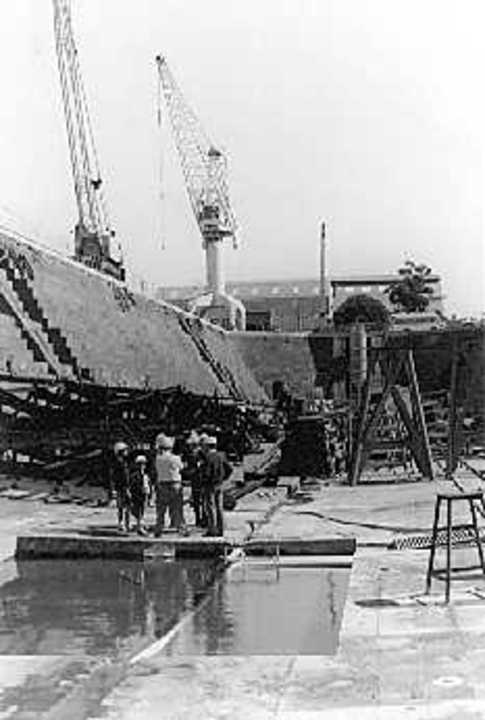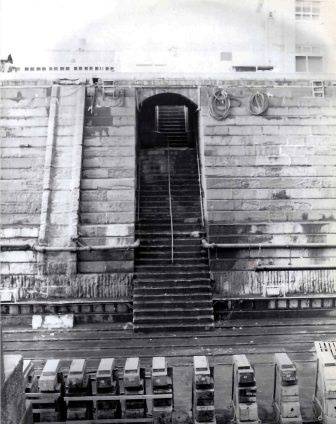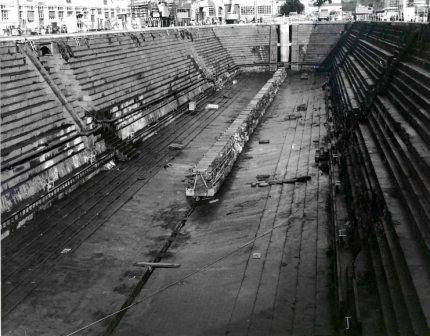| Back to search results » | Back to search page » |
|
Former Alfred Graving Dock
Other NameNaval Dockyard LocationPoint Drake, WILLIAMSTOWN VIC 3016 - Property No B2896
File NumberB2896LevelState |
|
Statement of Significance
The dock is situated in a complex of buildings, open space, shipyards and piers, in all occupying about six hectares. It comprises an excavated area lined with mortar bonded, closely inter-locking basalt blocks, generally about one metre cubes and is built in the form of an inverted arch. Classified: 06/05/1985
It may be closed by sinking a floating caisson or dock gate into a sealing gallery formed in the stonework at the end open to the waters of Port Phillip Bay.
The internal dimensions of the dock are approximately: 420 feet (128m) length, 97 feet (30m) width and with a depth of water over the sill varying between 24 and 27 feet (7-8m). Vessels of about 6,000 tons can be accommodated. The dock is emptied by mechanical pumps and filled through sluice gates in the ciasson.
The dock is abutted by wide paved areas along each side which provide for service machinery, materials and storage and construction processes.
The form of the dock is that of longitudinal stone terraces running parallel along each side, with a wide flat floor provided with drainage galleries and pump outlets. The terraces are interupted by a number of access stairways from the paved areas above.
Its architecture is of great Mayan terraces pierced for access galleries and stairways and intersected with dramatic stone flumes.
FUNCTION: The dock is used to provide dry docking for ships requiring maintenance or repair services. It has been used also for ship building.
Docking is achieved by bringing a vessel, usually bow first, into the dock, winching it into position with axis aligned above keel support blocks previously positioned and adjusted to accommodate the line of the keels of the particular vessel. The ship is then positioned and supported by use of timber shores between the hull and the dock terraces.
The dock is sealed by floating the caisson into position, admitting water and sinking it in the sealing gallery constructed in the dock.
Water is then pumped out to expose the entire external hull and fittings of the vessel.
HISTORY: A patent slipway to service vessels up to 2,000 tonne had been completed in 1858 which remained in use until 1911. However, the need for a dry dock had been expressed as early as 1855, one which could service much larger vesels and the Alfred Graving Dock was proposed.
It was designed by the Inspector General of Public Works W. W. Wardell and construction by Glaister & Co commenced in 1864 with the building of a 300 metre long timber coffer dam. The memorial stone was laid by H R H Prince Alfred on 4th January 1868 when total completion costs were projected to be about 185,000 pounds. The dock was completed in 1873 for a total cost exceeding 300,000 pounds and the first vessel to enter was HMVS Nelson in 1874, thus becoming the first line-of-ba ttle ship to be docked south of the equator.
In 1913 the dockyard became the State Shipbuilding yard and in 1918 the Commonwealth Government purchased the complex and stores for $400,000.00.
The Melbourne Harbour Trust purchased the dockyard in 1924 and later two nearby building berths were constructed to accommodate vessels up to 8,000 tonnes.
The Royal Australian Navy requisitioned the dockyard in 1942, it then being known as HMA Naval Dockyard, Williamstown. Its Present name is Naval Dockyard, Williamstown and is under the control of the Department of Defence Support, Commonwealth of Australia.
SIGNIFICANCE: The Government of Victoria built the dock in order to provide for the refit of the shipping upon which the colony's trade depended. The cost was high but the work was, as reported in the press of the day, "a highly finished and magnificent structure, not to be surpassed in the world".
It was the largest undertaking by the Victorian Government at that time and was of international importance as to use and of great engineering significance.
It is a tribute to the design and construction that the integrity of the dock structure is intact after more that a century of use in the knowledge that the soil condition in this area presents exterme engineering difficulties.
Despite the changes made over the years the dock remains one of the splendid and vital monuments to the vigour of maritime interests in the nineteenth century.
CONDITION: The original steam pumps are no longer at the site and the dock capstans have been removed although one is believed to be preserved near the Ferguson Street Pier.
The original iron caisson is no longer extant and the present caisson is of fabricated steel construction. None of the original cranes is present.
The stonework of the dock structure is largely as originally constructed although some alterations have occurred at access openings between ground level and dock floor. Alterations proposed recently include construction of small, shallow pits in the dock floor to enable specialised works relating to particular defence vessels. These pits will be formed by removal of whole stone blocks which will be retained for future reinstatement.
The pit surrounds will be re-inforced with grouted steel dowells. These proposals have been considered by representatives of the Trust and no serious objections have been raised to the proposed methods of alteration.
Group
Transport - Water
Category
Dock/Dry dock/Graving dock






